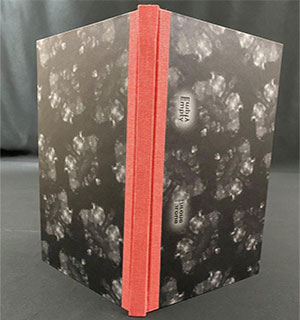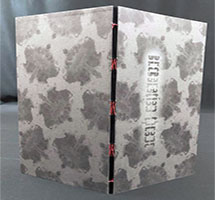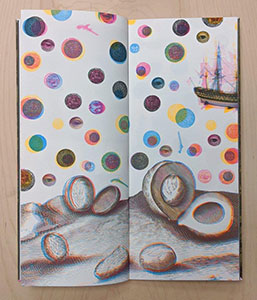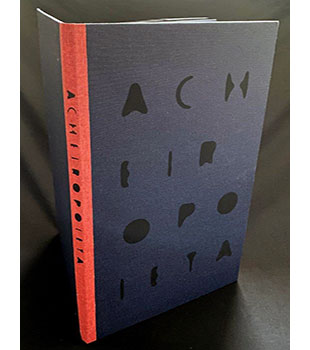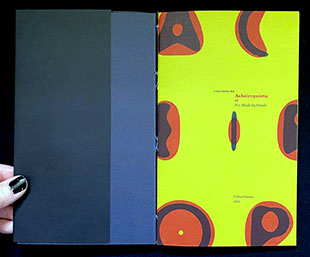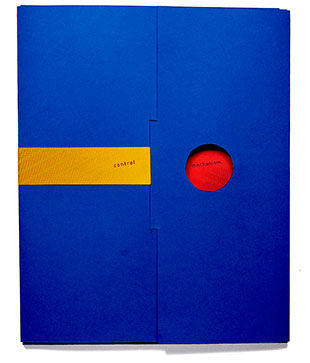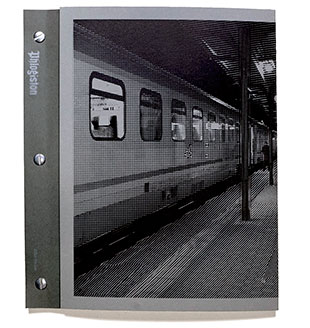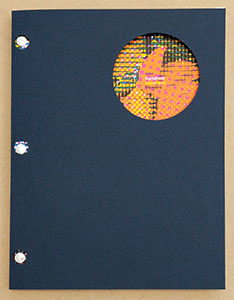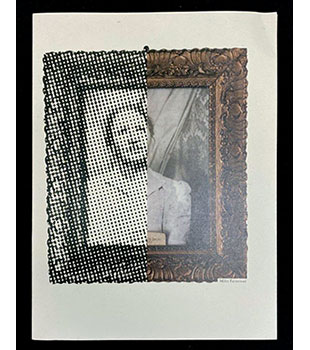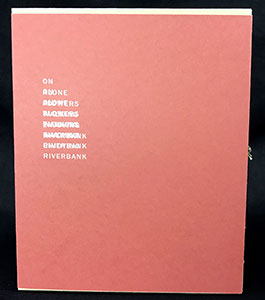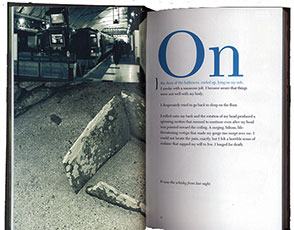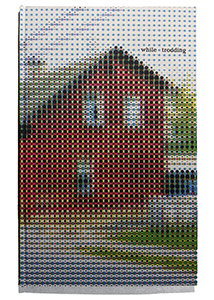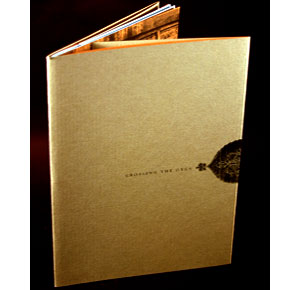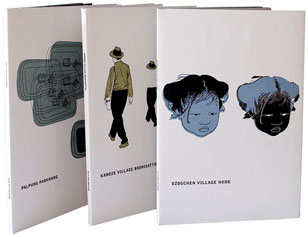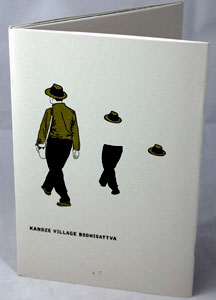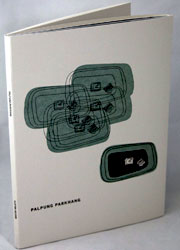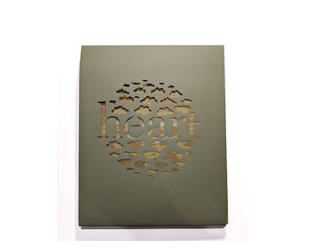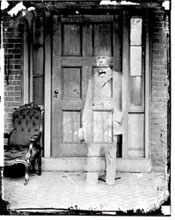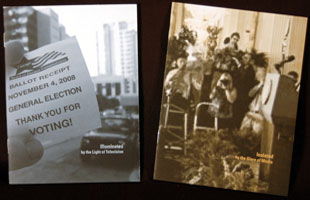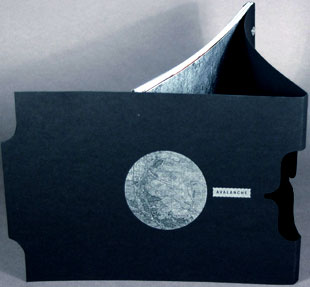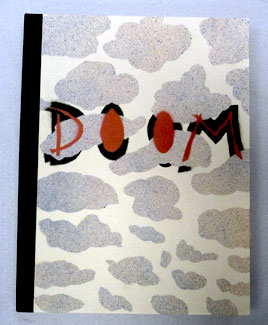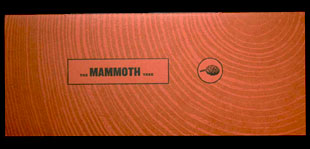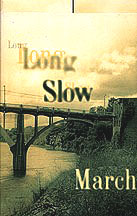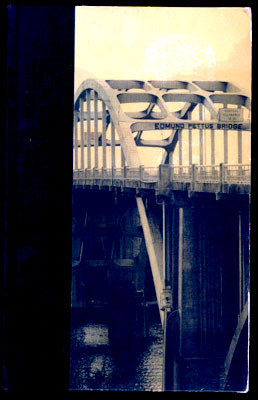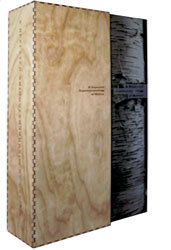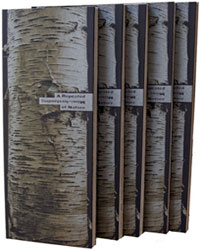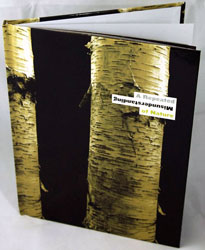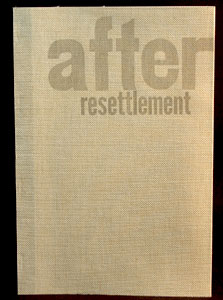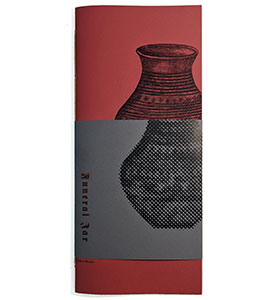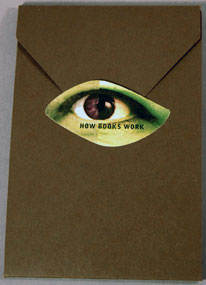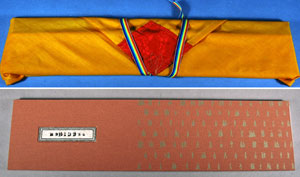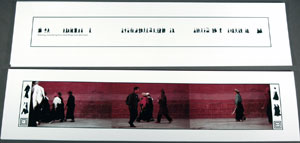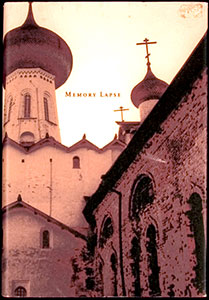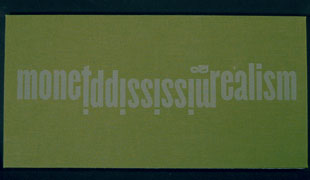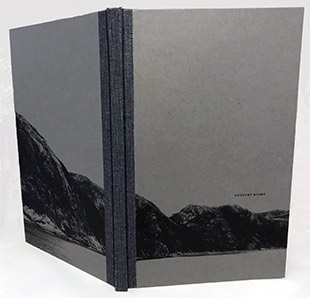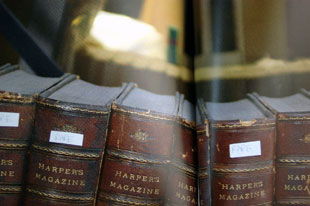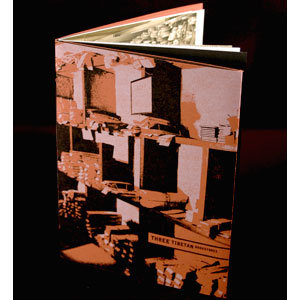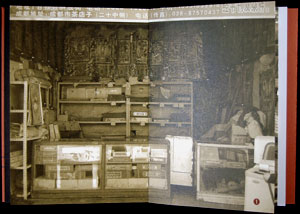
Clifton Meador ~ North Carolina |
Share this page: |
| |
|
Clifton Meador: "I make books: I make books that are intended to be seen as original works of art, not as collections of reproductions of art. This may seem like a pointless distinction, but when the author of a work has control of the final form of a work, then the piece of art is not a banal, commercial object, but something different, a real experience. "I have been making books-as-art since I was an undergraduate in art school. I find the book form endlessly fascinating: its strengths in telling stories and disseminating knowledge seem so rich with possibility. My recent work combines photography, writing, printing, and design to explore history, narrative, and place. "I am fascinated by the way a reader interacts with a book. A book (or at least the book I am interested in making) is portable, creates its own context, has a intimate relationship with its reader, and exists in multiple. The reader becomes immersed in the book, an act of willful self-hypnosis that is unique in art. The reader experiences this immersion in the book over time, allowing for complex, layered meanings to accrue. I am very interested in the development of an idea over time, from the accumulation of small details, hints, tiny nuances, broad gestures, and overwhelming contrasts. Every part of a book presents interesting possibilities for expression, discovery, and meaning." SFCB Shelter in Studio: Clifton Meador (May 2021): “Offset printer, book artist, and professor Clifton Meador calls in from one of the multiple print studios at Appalachian State University to show off some of their equipment and the artist's books he's made with it.” https://vimeo.com/551696111 |
|
Travels in Tibet books |
|
Empty Throne 15.5 cm by 25.5 cm; 64 pages. Offset lithography in silver and black ink on black and gray paper. Illustrated pastedowns and endpapers. Cloth spine with black and silver illustrated paper covered boards. Hand sewn and case bound. Clifton Meador: “About fifteen years ago, a friend of mine wrote to ask me why I didn’t make books with purely visual narratives. I think they were suggesting that my use of writing was a crutch, a way to avoid the difficult task of making a compelling visual narrative. The letter came during the time when I was almost finished working on a long project about the Derge Parkhang, a sutra printing temple located on the eastern border of the Tibetan Autonomous Region, and I had a great many pictures from that project for which I did not have a use. I immediately started working on a sequence of those images that I thought told a story of a trip into the high mountains of Eastern Tibet, leading a viewer into a visually allegorical journey of revelation. “When I finished designing the sequence, I knew that it did not do what I had hoped. I felt like it was missing some major element, something that would propel the narrative in a compelling way. Photographs record detail and texture with astonishing fidelity, but photographs present abstract ideas very poorly. My visual narrative was supposed to be largely allegorical, and the work I produced seemed merely confusing. “I put the sequence aside, returning to it many times over the intervening years, trying to understand how I might make something that told the story without using written English. I tried several very different approaches to the problem, including one version that was an imageless, entirely written translation of the visual sequence. As a companion piece to the visual narrative, I think it was my attempt to locate the narrative in my mind somewhere. None of these efforts seem to accomplish the goal of presenting a visual, allegorical narrative. “One day, about two years ago, I was rereading an article about the transmission of Buddhism to Tibet, and I was reminded about Termas. A Terma, in the Tibetan Buddhist tradition, is a hidden teaching that is discovered or revealed by a person who is then called a Tertön. Termas can be located in physical objects or in the minds of people, and they are often encoded in a nonhuman writing system, only legible to the Tertön, called Dakini script. Padmasambhava, who is supposed to have brought Buddhism to Tibet during the Eighth Century CE, had some teachings that he knew the people were not ready to hear yet. He hid these teachings in physical objects and in the minds of people in the future. These teachings have been discovered by various masters over the years, in a process of continuing revelation. “I thought about how I had been struggling to make photographs readable in a certain way, and it occurred to me that the photographs themselves might become the source of a writing system. I went through the photographs, found tonal highlight sections of the images that could be isolated, rotated and duplicated, and thus translated into glyphs. They form a text that is not immediately legible and that accumulates page by page through the work. Of course, for the right person this text will become readable. “To produce Empty Throne, I took a physical copy of the visual narrative book I had been struggling with for years, and I photographed each page spread as I held it in my hand while walking up the hill beside my studio. I designed the book so that most page spreads have the original image printed on one side, and an image of the book with the same image on the other side. The silver glyphs accumulate on each page spread, new glyphs being introduced on the pages with the images from which they are derived. The image on the last page spread in Empty Throne is of the field next to my studio, with the first glyph of the text floating in the sky. I printed the book in two and three colors of black on gray paper in order to totally suppress the highlights of the photographs. The glyphs are all generated from the hidden highlights in the images, and they are meant to be the light in this work. “In early Christian art, as well as in early Buddhist art, an empty throne was a way to portray someone who couldn’t be represented: Christ and the Buddha were both represented as empty thrones in early representations, as a way of pointing at something amazing that could not or should not be directly portrayed. This book is full of people lost in the night, empty thrones, empty saddles, struggling frogs, and a text that can’t be read.” |
|
Preparation Throne 15.5 cm by 25.5 cm ; 48 pages. Offset lithography in silver and black ink on black and gray paper. Stiff illustrated wraps with exposed sewn binding. Clifton Meador: “A related project, Preparation Throne, was printed before I started printing Empty Throne. I printed many of the glyphs in silver ink on black paper, and I think of it as the pure, unreadable version of the text revealed in Empty Throne.”
|
|
VOC 6 x 14"; 96 pages. Printed by offset lithography in fluorescent colors. Hand sewn and case bound. Clifton Meador: "I was, like so many other people, stuck at home during the Pandemic. In addition to the relentless doom-scrolling of reading infection and mortality figures, I spent time looking at the websites of museums I could no longer visit. “One site was particularly well designed and user-friendly: the Rijksmuseum in Amsterdam. As I clicked through the images of paintings, furniture, flatware, guns, metalwork, objets de vertu, coins, glass, and silver, I started thinking about the Netherlands in the 17th century and the vast wealth that was evidenced in the Rijksmuseum’s collections. I started reading about the Dutch East India company. “Chartered in 1602, the Dutch East India company—or in Dutch, Vereenigde Oost Indische Compagnie, referred to as the VOC—was the first publicly traded corporation in the world. The VOC was established to commercialize the highly profitable spice and silk trade with India and the East Indies by spreading the risk incurred by individual ships attempting the long and perilous voyage to the East. The VOC aggregated the costs and then distributed the profits (and the losses) of many separate voyages, eventually creating a source of immense wealth for its investors. The VOC became a multinational company-state, perhaps the largest commercial organization in history, with its own military forces, fortresses, and quasi-independent city-states across South Africa, India, and the East Indies. The VOC was able to independently wage war, coin money, negotiate treaties, establish colonies, enslave people, massacre Indigenous populations, and create spice monopolies by burning entire islands belonging to its competitors. “The so-called Dutch Golden Age of the 17th century contained massive contradictions: a society that exported extensive, violent colonialism, while at the same time supporting many creative practitioners, allowing relative freedom of the press, and providing tolerance for some level of dissent. In this project I focused on using the collection of the Rijksmuseum to suggest this contradiction and to tell, using only objects from this collection, the story of the birth of the VOC and the resultant wealth of the Dutch Republic. My goal was to show how luxury goods, still life paintings, metal work, objets d’art, portraits, and weapons were the product of an extractive colonialism. "My strategy was to color-separate the high-resolution files downloaded from the Rijksmuseum and then to recombine the images of these objects, to create representations that do not illustrate any one thing—an illusion of inchoate, but richly crafted, possessions. The introductory section of the book presents the charter of the VOC and reveals some of the conflict surrounding the Dutch presence in the East Indies in the form of contemporaneous title pages; subsequent sections of the book suggest the resultant wealth this colonial project produced. The final section of the book presents chimerical portraits—images of affluent Dutch people from the 17th century, recombined to make composite images of people who never existed—that are then overprinted with engravings from the 17th century that document some of the violence associated with the VOC. "I imagined this project as a museum catalog gone completely wrong: reproductions mangled, images misregistered, odd fragments recombined from wildly different sources, cropped badly, with colors transformed into something from a hallucination. I imagined that in this catalog all text—including the vitally important informative, contextualizing captions for the images—would be removed. Gone would be the gallant, abridged histories provided by any museum, normally present in the image descriptions, but now entirely absent. The reader would be left to construct their own narrative from this unreal evidence. "And my hope is that the evidence of this museum catalog is so unreliable, so tainted by its own distorted agenda, that the reader is left with nothing other than a vague impression of a horrific cataclysm swimming around illusory objects of great beauty, virtue, and price." |
|
Acheiropoetica and Concerning Acheiropoetica Acheiropoetica: 12 x 19"; 36 pages. Printed from dye sublimation cotton cloth positives. Printing plates self-screening shadows of those textile separations. Resulting plates printed on a Heidelberg KORS one color at a time. Stiff wraps in black dust jacket with title letters cutout on front. Hand sewn binding. Laid in cloth bound portfolio with titles in black on front cover. Numbered and signed by the artist. Concerning Achieropoieta: 5 x 8"; 36 pages. Stiff wraps in black dust jacket with title letters cutout on front cover. Hand sewn binding. Clifton Meador: " Acheiropoetica is a book of experimentally printed offset-lithographed images that offers a visual discursion on themes of miraculous images, chattel slavery, cotton cloth production, the invention of photography, and the political nature of all images. A satellite book, Concerning Acheiropoetica, is a small book that discursively considers the images in Acheiropoetica. Acheiropoetica is a large book, 12 by 19 inches. Big books are public experiences-looking can be shared by several people at once. Concerning Acheiropoetica is a small book, 5 by 8 inches, barely hand sized; it is thus a private reading experience." Clifton Meador: " Acheiropoetica (which means not made by hands in Greek) are a class of Christian icons that are supposed to have come into being miraculously. Many Acheiropoetica are textiles that purport to show the trace left when divinity comes into contact with cloth. In the Orthodox Christian tradition, their authority is unquestioned. The Shroud of Turin, the Veil of Veronica, and the Mandylion are all examples of images formed through physical contact with Jesus. "Religious claims aside, the idea that Acheiropoetica are examples of unmediated images-images that are formed without any human intervention-is intriguing. Photographs and mirrors used to offer images that were assumed to be unmediated, images that had authority, but photography began to lose its role as trusted reporter very early in its history, and today's digital editing techniques have made it clearly subject to authorial intervention. For a while, daguerreotypes did retain a certain veracity. Each one was unique, a particular record of a precise moment, a chemical rendering of an optical condition. Add to that the fact that they were made on highly polished silver plates-mirrorlike-made them seem as truthful as a mirror. "Even as they were seen as authoritative, mirrors have always been suspect-tools of the devil, windows into evil-but they are still trusted by many as a way to examine one's own face. However, the lateral translation of a reflection and the distortion of the glass and reflective coating make it as unreliable as an oil painting. Think about how odd your own face looks to you when you see it in a photograph as opposed to how it looks in your bathroom mirror. "The loss of meaning and trust in images has been a gradual descent into a world of immersive media, where meaning is a process rather than a destination. As artifacts of human contrivance, photographs now lack all authority, semblance of truthfulness, or unquestioned meaning; they seem contingent, lacking any center or substance. In fact, most photographs today have no physical existence at all. I am interested in how images might be made to seem unmediated, how they might be made to revert to a kind of solidity. "Woven cloth forms a raster, a grid of threads that forms a fabric. When seen by transmitted light, the warp and weft of the cloth forms a variable density grid-which calls to mind a halftone contact screen, a predigital piece of technology that translated continuous tone images into fields of halftone dots in order to simulate tonality. In this project, I created color separations of images, print them through dye sublimation technology onto cotton cloth, and use those pieces of cloth to directly expose offset lithographic printing plates, which would then be used to print three-color images. The weave of the cloth itself would break down the continuous tone image into dots of varying size. "In a very literal way, I wanted to create a material metaphor to elaborate the idea of an acheiropoieton- where the lithographic shadows of the cloth images were multiplied into a book. "But there is a problem inherent in cotton cloth: Cotton production has a long and horrible history. Sven Beckert's great book, Empire of Cotton, details not only the development of chattel slavery in the New World in response to the growing demand of the textile mills in England, but also the troubling history of cotton in the Old World. Cotton cloth-comfortable, easily dyed, beautiful-comes with a long, miserable history of human suffering and exploitation." |
|
Control Mechanism 56 pages; 8.75 x 10.75". Offset lithographed in fluorescent colors. Printed on Mohawk Superfine. Sewn binding with red covers. In blue paper fold cover. Clifton Meador: "A factory in transition from workplace to event venue is haunted by Foucault’s ideas of a disciplinary society and the ghosts of former workers. But I myself feel like a ghost in our society of control—which promises a fake freedom based on precarity and fear. "I was taking pictures of a beautiful factory that was being converted into a venue for cultural use and I vaguely remembered Foucault’s disciplinary societies as social structures in opposition to societies of control. Looking at that factory led me to thinking about the illusion of freedom offered by our gig economy, where the fear and precarity of freelance employment are supposed to represent freedom from the discipline of shift work in a factory. "In his essay 'Postscript on the Societies of Control' Gilles Deleuze wrote: 'In the disciplinary societies one was always starting again (from school to the barracks, from the barracks to the factory), while in the societies of control one is never finished with anything–the corporation, the educational system, the armed services being metastable states coexisting in one and the same modulation, like a universal system of deformation.' "This work uses coarse line screens to print photographic images and the instrumentality of representation becomes more interesting than the illusions it attempts to create. The placement of the typography echoes the angles of the line screens and the ghosts of former workers only exists in this work as very blurry typographic forms. "I printed this book on an offset press, one color at a time—a process something like factory labor." |
|
Phlogiston 46 pages; 8.375 by 10.75 inches. Offset lithographed in split fountain and black. Printed on Mohawk Superfine Post bound with wrap cover from back to front over fore-edges. Clifton Meador: "When the Pandemic started, like many people, I started reading books about the plague. Daniel Defoe’s 'Journal of the Plague Year' — while tedious — caught my imagination. So many of the things he described in London in 1665 seemed familiar. The rich fleeing the city, leaving their servants behind to protect and maintain their properties (and thus die from the plague!), strange ideas about the origin of the plague circulating wildly, and an odd precursor of doom-scrolling—a daily publication in the City of London of deaths— becoming a popular obsession. "Looking over the digitized books in the internet archive on the topic of the plague left me with the impression that there were a very large number of books written about the plague! Being fascinated by the history of typography, I started collecting the title pages of these books. One thing led to another, and I produced this little project of the bills of mortality printed opposite overprinted plague book title pages. During this process I discovered that one of the risograph colors in our studio is somewhat opaque, and that led to the cover. "History feels like a pile of old title pages: nothing human is really new, and this plague is either a re-run of an old story, or foreshadowing of something much worse." |
|
One Hundred Excellent Flowers 8.5 x 11"; 62 pages. Florescent four-color offset lithography. Post-bound book with die-cut paper wrapper. Clifton Meador: "On February 27, 1957, Mao Zedong gave a speech titled 'On the Correct Handling of Contradictions Among the People.' In this speech, he quoted a poem: 'Let a hundred flowers bloom / Let a hundred schools of thought contend.' His speech invited citizens to voice their opinions and criticisms of the Communist Party. "It was followed in the summer of 1957 with the Anti-Rightist movement, where between 300,000 and 550,000 individuals were identified as Rightists - most of whom were intellectuals, academics, writers and artists. Mao later said the Hundred Flowers movement had enticed the snakes out of their lairs. The majority of those accused of being Rightists were publicly discredited and lost their jobs or worse. "Historians argue whether Mao was sincere in his desire to encourage free expression and came to regret it, or if the entire Hundred Flowers movement was a trick to expose his enemies. "During the fall of 2018 — like many other people —I became angry at the sense that lying has become an acceptable rhetorical strategy. My anger spread to contemplation of the myriad ways we are being lied to, from politics to marketing. It was late summer in western North Carolina, and I had been photographing flowers since spring. I had been thinking, as I have for a long time, about how photographic representation presents nothing other than itself — a printed image is just ink on paper, not a magic window into an alternative reality. The way an image gets printed — the technical issues in printing — are a large part of the reception of the image. I determined to make the technical necessities of image production into an issue in this piece - interfering with the way a raster creates tone by making it obvious and expressive. "Flowers are a trick to seduce pollinators into helping the plants reproduce. I saw the snack foods as seductions, lies of a different kind, and I took parts of Mao's speech and reiterated it for a consumer's lament. " |
|
Miller Farmstead 9 x 12"; 44 pages. Printed on a Kodak Nexpress (a digital press). Saddle stitch binding. In stiff book wrapper with translucent paper dust cover. Signed and numbered by the artist. Clifton Meador: "Miller Farmstead is an old Appalachian farm-turned-museum that is now part of a state park in eastern Tennessee, in the mountains on the border with North Carolina. The museum preserves a house and farm just as it was in the 1960s, a successful subsistence farm of southern Appalachia. The house-museum has an unreal sense to it-almost as if the owners had just walked out the door, leaving the home unlocked. When I visited it, visitors were free to wander anywhere in the building, pick up artifacts, rummage through drawers and in closets. The museum offered little in the way of contextualizing material or exhibition contexts-the remains of these lives are evident only through these remnants. "Photographs seem immediately nostalgic, being so descriptively attached to one precise moment that they evoke the past compellingly. The nostalgia evoked by a photograph has a tricky relationship with truth, drawing more on the viewer's knowledge and experiences than any objective reportage. I was keenly aware that as I took these pictures, I was carefully selecting things that fit within my own biases and preconceptions about this place and these lives. As I was designing the book, I was interested in how a graphic translation that broke down the illusions created in the printing process would erode the reading of the images. "The truth of photography is a well-understood fiction, and nostalgia is a dangerous feeling. And the idea that an image could represent something real, the idea that something is verifiable, seems like a quaint notion now." |
|
On Riverbank Three 28-page booklets, 8 by 10 inches. Printed digitally and by letterpress from photopolymer plates and woodtype. In a paper slipcase. Clifton Meador: "Each booklet contains a different iteration of the same set of images and text: the images are photographs of reflections on the surface of the Emajogi river in Tartu, Estonia, while the texts are transformations of poems by Du Fu, the great Tang Dynasty poet (712 - 770). I selected poems that mentioned rivers, and then created very bad translations of these poems by using automated, literal translation software. The resulting word salads were transformed into two new poems: for the first booklet, by alphabetized by first work of each line and for the second booklet, the text was produced by resorting the poem by word length. The third booklet presents the original Du Fu poems, in characters. "Printing images always involves translation—from a digital file to splats of ink on paper, from a relief matrix to ink on paper, or from conception to its manifestation. Each of the three booklets iterates the same sequence of images in a different way, firstly as two-color separations overprinted with silver type, secondly as a coarsely screened version of the same images, overprinted in larger words, and finally as a variable-ruling line screen with wrong-reading texts in fluorescent ink. "The unintended meanings created through the artifacts of printing and careless bad translation are meanings nonetheless, and the process of finding meaning never has a final destination. "This project was printed during a very brief residency at Penland in January of 2017. " Clifton Meador, more: "In a direct way, it was the precursor to 'While Trodding'. I got re-interested in the ways that printing translates photographic images, and during my residency in Tartu, Estonia in July 2016, I started making images that are more about that translation than about representation. I started printing 'While Trodding' before I had the residency at Penland, but the idea for 'On Riverbank' came before that." |
|
| Whiskey Defense By Clifton Meador Atlanta, Georgia: Nexus Press, 2001. Edition of 1000. 5.5 x 8.5", 160 pages. Duotone, tritone and four-color offset printing. Case bound with cloth over boards and offset printed dust jacket. Nexus Press: "A story about the history, culture, and whisky of Scotland, the clever text of Whisky Defense is paired with hauntingly digitized images of Scotland. Califia Books: "The recovery from a hangover begins a journey through the history of Scots, Scotland, and Scotch. Photos of archeological sites and rural peat fields fuse with images of train stations and hotel lobbies, suggesting that ancient and modern, past and present can exist simultaneously. The text is spare and poetic, juxtaposing the history of conquest, the composting and harvesting of peat, the distillation of whisky, and the act of imbibing. Thus, history is layered in the very land and can even be tasted. As soon as enough sugar is converted, the malted barley is dried over a peat fire to halt the germination. The growing life within the barley seed will consume all the freed sugar if not stopped by the heat of the fire. The burning peat leaves an ineradicable trace: the flavor of the peat bog, turned to smoky residue in the fire, persisting in the finished whisky eighteen or even twenty-one years later. Forever, in fact. This is a visual novel that relies, in order to tell its story as much on the assemblage of images that fill each page (and provide a subliminal backdrop to the text) as on the text itself." $85 |
|
| Johanna Drucker: "Clifton Meador's most recent books move across the arid zones of the Republic of Georgia, into Bukara, Khiva, and Uzbekhistan, and through the interior spaces of abandoned monuments, occupied gardens and streets, and into the village of Kardanakhi. They do not depict these exotic locations so much as they move the reader-viewer through them. Meador's narratives create pathways up, down, across, along, and through the many spaces of the book that are the framework and substance of his designs. Few book artists have had as extensive and creative a dialogue with the codex as a dynamically structured space as Meador has over the last twenty-five years. He understands book form as a literal, referential, conceptual, physical, temporal, and virtual space, and he knows how to maximize each of these registers for complex effect. The result is elegant and smart, especially since his content is adventurous, informed, and imaginative." | |
While Trodding 10.25 x 6.5"; 36 pages. Printed in four-color risography in non-standard process color by Jason Wright during the fall of 2016 and spring of 2017. Case-bound in a digitally-printed cotton cloth. Signed and numbered by the artist. Clifton Meador: "During a residency at the Truukimuseuum (a printing history museum) in Tartu, Estonia during the summer of 2016, I became interested in the narratives embedded in Soviet-period photo books. Many of these books seemed to embody cold war narratives of surveillance and paranoia, hidden in banal images of everyday tourist sites. I re-photographed several of these books which have become other projects on their own. "But one book in particular, a friendly tourist book from the period of the Soviet occupation of Estonia (first from1940 to 41, then from 1944 to 1991), Osvald Tooming's Matkates Mööda Kodumaad, 1964 (Hiking Through the Homeland), was full of captions that suggested readings other than simple observations of Estonia. I edited fragments of these captions and I set out to make my own guidebook of the walk from my apartment in Tartu to the train station, printed in such a way as to make the images as nearly unrecognizable as possible." |
|
Crossing the Oxus 7 x 11"; 24 pages. Photographs taken by Meador in Uzbekistan in 2000. This is "a little book about the drying up of the Aral Sea in Uzbekistan." The understated tone is typical. The Aral Sea was once the fourth largest body of fresh water on the planet. No longer. This cautionary tale, told in photographs and Meador's sensitive but incensed text, recounts the plight of the Oxus River, which "in classical times … was the boundary of the known world." Soviet mega-planners determined that Uzbekistan would be the cotton producer of their empire and that the Oxus River (now called the Amu Darya) would be diverted for vast irrigation projects. When Meador crossed the river in the year 2000, it a "vanished river" — victim of "one of the largest and most horrifying ecological disasters in the world." |
|
| In 2007 Meador produced "Kora" a book about Dege Parkhang, a printing temple located in Ganze Autonomous Prefecture in western China. He has continued with a series of books based on his travels and experiences in Tibet. | |
| Dzogchen Village Home By Clifton Meador Chicago, Illinois: Clifton Meador, 2012. Edition of 200. 6 x 9"; 48 pages plus four panel double-sided pull out page at back. Stitch bound. Offset printed with a letterpress printed dust jacket. Cliff Meador: "This is one of three books that is based on work I did in Ganze Autonomous Prefecture. I was there as part of an interdisciplinary research team, documenting traditional Tibetan book culture, and much of the information we collected has never been published. I spent part of this summer printing these books that explore ideas of iteration and repetition that are connected to the practice of traditional Tibetan book production." Dzogchen Village Home: "Dzogchen is a Tibetan Buddhist practice intended to bring enlightenment by returning to the primordial condition of the mind: an all-encompassing timeless awareness, an openness to everything, all situations, all people, undefended, ready to experience. The practice of dzogchen is supposed to be everyday life itself. "Dzogchen is also a monastery, in a glacial valley, in Ganze Autonomous Prefecture, part of the great Nyingma tradition, and the seat of the Second Dzogchen Rinpoche Gyurme Tekchok Tenzin who is supposed to have instructed the King of Derge to build the Parkhang." In this third of his books documenting his time in the Ganze Autonomous Prefecture, Meador takes his reader into the home of one of the residents of this high remote town in Tibet. $30 |
|
| Kandze Village Bodhisattva: Nine Iterations By Clifton Meador Chicago: Clifton Meador, 2012. 6 x 9"; 52 pages. Offset printed. Pamphlet stitch bound. Slipped in letterpress printed dust jacket. Cliff Meador : "This is one of three books that is based on work I did in Ganze Autonomous Prefecture. I was there as part of an interdisciplinary research team, documenting traditional Tibetan book culture, and much of the information we collected has never been published. I spent part of this summer [2012] printing these books that explore ideas of iteration and repetition that are connected to the practice of traditional Tibetan book production." The book unfolds to two page-sized flaps. Inside the left flap is bound Nine Iterations, a 13-page booklet. The booklet's first spread has an arrangement (abstract? a pattern?) of numbers and page numbers (e.g. page 14 is above the number 6). The succeeding pages detail nine parts of a narrative, gradually accumulating detail and meaning with each telling. In the text some words are given numbers (something is 1, bridge is 2 …). Nested within the right flap is a book of photographs, delicate grays with green and yellow overtones. These photographs depict the narrative recounted in the booklet, Nine Iterations, each photo showing a portion of that narrative. Certain things in the photographs are labeled by numbers. These numbers correspond to the numbers in the booklet narrative. By working back and forth between the text and the images and using the key provided in the arrangement in the first spread of the booklet, one can understand that each iteration (be it by word or by image) is a partial representation of the whole experience. This is clever version of the parable of the blind men and the elephant, where each version is true but incomplete. $30 |
|
| Palpung Parkhang By Clifton Meador Chicago: Clifton Meador, 2012. Open edition. 6 x 9"; 52 pages. Stitch bound. Offset printed with a letterpress printed dust jacket. Cliff Meador: "This is one of three books that is based on work I did in Ganze Autonomous Prefecture. I was there as part of an interdisciplinary research team, documenting traditional Tibetan book culture, and much of the information we collected has never been published. I spent part of this summer printing these books that explore ideas of iteration and repetition that are connected to the practice of traditional Tibetan book production." Palpung Parkhang is the second in this series of three (Kandze Village Bodhisattva: Nine Iterations is the first). This book uses similar structure, a letterpress printed dust jacket with flaps that hold a book of photographs on one side and a book of text (in this case, 5 sets of notes, like footnotes) on the other. Meador took the photographs during his visit to Palpung Monastery in Palpung Parkhang, Tibet. In most spreads there is a number (starting with 1 up to 20). These numbers correspond, or seem to correspond, to the notes (yes, each of the 5 sets of notes contains 20 notes) in the text section that tell a version of the experience. So using the same photographs and the 5 sets of notes, this book takes us on five different trips, each the same, each different. $30 |
|
heart 8.5 x 11"; 64 pages. Printed offset lithography on a Heidelberg KORD. Case bound with illustrated paper covers and patterned cloth spine. Laid in illustrated wraparound. In black paper full band with laser cut design. Clifton Meador: "In the summers of 2006 and 2007 I traveled to Kham, a historically Tibetan area, as a member of an interdisciplinary study group. We were there to study traditional Tibetan book production, particularly at the Derge Parkhang. We traveled to many other monasteries that still print books, and at Babang we met an old lama, the brother of a famous thangka painter. Meeting him changed my awareness about what I do: orientalism and the exotic still have a hold on me, no matter how hard I struggle against them. This book starts with the mantra from the Heart sutra, and structures a travel experience around it. In March 2008, I printed a limited edition, offset lithographed and hand bound version of this book at the Center for Editions, Purchase College." Artists’ Books Unshelved: Beyond First Impressions |
|
| History plays an important part in Clifton Meador's works. United States history especially that surrounding the South and civil rights. | |
| Victory / Defeat By Clifton Meador Chicago, Illinois: Clifton Meador, 2012. Edition of 100. 4 x 9"; 8 pages with 2 fold outs. Saddle stitch binding. Paper wraps. Clifton Meador: "I've been thinking a lot about victory and defeat recently." The covers are from a Washington, DC newspaper of April 10, 1865, announcing General Lee's surrender at Appomattox. The images are from Matthew Brady's photographs of Lee taken 10 days later. $12 |
|
| Illuminated by the Light of Television & Isolated by the Glare of Media By Clifton Meador Chicago, Illinois: Clifton Meador, 2010. Two booklets in yellow title band. Each booklet: 4.5 x 5.75"; 14 pages; offset printed. Letterpress printed band. Printed and produced at the Columbia College Center for Book and Paper Art. Clifton Meador: "The pamphlet was originally an insert in the Blue Notebook Vol 3 No2, May 2009. This book pretty much covers my emotional arc about the President [Obama] - from euphoria to disappointment." $12 |
|
| Clifton Meador Sold and Out of Print titles: |
|
Avalanche 11 x 8"; 52 pages. Post binding. Cover folds over from back to front then slips into spine for closure. Each 22" leaf folded to two 11" pages bound into spine at open end. Avalanche—artists’ book as travelogue—recounts a 2003 road-trip on the Georgian Military Highway from Tbilisi to the Russian border. Meador’s photographs and maps wrap around the pages imitating the winding road and terrain. The commentary, delivered in typographical spurts that jump and sputter like the beat-up “clapped-out Niva,” permanently stuck in low, that lugged Meador northward, detours here and there, to Azerbaijan and to the first Gulag near the White Sea, to the office of the rector who tried to exhort a bribe from Meador, in Georgia on a US government grant to teach. It ends within sight of the Russian border at a monastery, the subject of a Pushkin poem “hopelessly romanticizing the Caucasus.” The gritty-gray photographs, which take on a faint halo of color near the journey’s end, and the information are worth the price of admission. What if offered for free is the spirit of the road — priceless. |
|
| Book of Doom By Clifton Meador Rhinebeck, New York: Spaceheater Editions, 1984. Stated edition of 50 (35 actual). 10.5" x 14" closed, 18" x 25" when fully opened. Hand-cut stencils. Pin-registered spray enamel paint on Rives BFK paper. Bound by Philip Zimmermann with an accordion spine strip. Housed in a custom spray-painted clamshell box. Phil Zimmermann: "Spaceheater Editions published Clifton Meador's BOOK OF DOOM during the summer of 1984, in Rhinebeck, NY, USA. Clif used multiple pin-registered hand-cut stencils to spray enamel paint onto Rives BFK paper. The edition was to have been 50 but only 35 were made. Clif did all of the spraying. [I] made most of the boxes and did all of the bindery work. "Clif's text and images tell a tale of an end-of-millennial apocalyptic journey into the depths of hell. When the pages are flipped over at the end of the book, it forms a downward spiral that is very reminiscent of the circles of Dante's Inferno. "Clifton Meador writes: 'The initial impetus for this book was to complicate the experience of reading a book through an intricate sculptural experience. Like many other artists, I was interested in thinking about a book as a kind of performative sculpture, a complex structure that the reader has to manipulate in order to read it. I wanted to start with a simple story, so I could make the form as complicated as possible while maintaining a narrative thread. It was 1984, so I imagined the end of the world might be an interesting story to complicate. "The governing visual idea was that when the reader had finished unfolding all the pages and the book was completely open, the book structure would resolve into a mandala, with all the pages contributing to a final image. Since the book was about the end of the universe, an apocalypse of plastic and radios, I found medieval manuscripts were an important visual source for this work, and a Spanish-Mozarabic Apocalypse of the tenth century was a particularly rich source of color, pattern, and a flattened sense of space. "At the time I made this book, I had no access to printing equipment, so I produced the edition with pin-registered stencils that I sprayed with four colors of spray paint. When I started this project, I hoped I might be making positive plates from the spray paint separations, but the richness of the spray paint alone convinced me to produce the edition that way. Phil Zimmermann was very supportive of this project, and published it under his Space Heater Editions imprint. The clever spine structure that holds the page units together was an invention of Keith Smith, who took one look at it and saw the right way to put it together.” (SOLD/Out of print) |
Additional features of the book can be seen in this video link: |
Felling the Mammoth Tree of Calaveras County 5 x 12", 16 pages. Pamphlet stitch binding. Printed and produced at the Columbia College Center for Book and Paper Art. This pamphlet is part of a series of books called Grove. The images for this work were taken at the Calaveras State Park, in California during the summer of 2011 Clifton Meador: "The Giant Sequoia of the Sierra Nevada mountains are survivors of the last period of climate change. These huge trees used to be widespread - they grew all over the continental United States. As the climate changed during the Pleistocene Epoch, their range became limited to the western slopes of the Sierra Nevada at an altitude of 3,000 to 8,000 feet. They now survive solely in groups called groves, and there are only about 70 groves left. They are among the largest living things ever to have existed on Earth: one tree in Sequoia National Park is estimated to weigh 1,800 tons. "During the nineteenth century, California seemed like the promised land, a place where luck and gold ran in rivers. The news that humongous trees were growing in the Sierra Nevada mountains seemed like a myth, and the story was met with skepticism - assumed to be part of the hyperbole that surrounded the Gold Rush. The insistence that they were real, and enormous beyond anyone's experience, created a flurry of interest. Skeptics in the East demanded proof - tangible evidence. So, an enterprising soul decided to cut down the biggest Sequoia he could find. It happened to be a tree that Augustus T. Dowd first saw in 1852 in the Calaveras grove. Who is surprised that the first giant tree encountered by a European settler was destroyed in order to prove that it existed?." |
|
Long Slow March 5.5 x 8.5"; 235 pages (unpaginated). Perfect bound hardcover in illustrated dust jacket. Photomontage. Offset printing. Type designed by the author. Johanna Drucker, in JAB 12: "History plays an important part in Meador's new works ... Long Slow March documents the history of African-American struggles for civil rights in the United States, taking the concept of narrative into the social domain where it creates both real and imagined histories of lived events. Meador uses photographs he made of the route of the famous march from Selma to Montgomery, Alabama, led by Martin Luther King in 1965 and other documentary material. He collages and splices his version of this history into a single book, but one that refuses to coalesce around a simple line. His identity as a Southern white man, raised in the era of the civil rights movement, is the point of departure for the work. There are no easy ways to tell historical tales, no singular perspectives from which to objectify the interwoven subjectivities that form our past." Clifton Meador, JAB 12: "Long Slow March weaves together multiple narratives focused on a theme: the African-Americans' struggle for civil rights. The Selma march (itself a narrative structure) forms the backbone of the book; the limbs of the book (primary source texts and photomontage of slavery and the civil rights struggle) hang on either side of it. The first section is a typographic lift of an old form, the polyglot bible. Polyglot bibles presented an original text in its original language, with commentary in translated languages surrounding it. This form seemed suitable for combing slave narratives with slave owners' rationalizations for slavery, since this typographic form preserves the autonomy of the texts while suggesting that the reader consider the texts together. "Having presented the history of the struggle (in warped abbreviated form) as a prelude to the central issue, the heart of the book is literally the road from Selma to Montgomery, photographed every mile or so. Title pages from slave narratives begin to hang in the air, floating overhead, witnesses to the march. Eventually, as the march (road) nears Montgomery, mainstream newspapers start publishing attacks on the march, on the participants in the march, and on the idea of civil rights. It was a shameful rearguard action on the part of people who should have known better; the evidence hangs in the air over the road. Using a shift in color to indicate a shift in narrative, images from the actual march in 1965, end the section of the book that addresses the march itself. Pictographic Klan warnings are knocked out of the documentary photographs, emblems of the persistent repression that impeded the struggle for civil rights. The last section of the book is a conflagration of all the forces and interests that collided over the civil rights struggle. "History itself is a confusing narrative, continually rewritten from the viewpoint of the reader." |
|
A Repeated Misunderstanding of Nature Prospectus: "A Repeated Misunderstanding of Nature is a set of five leporello books, each presenting a sequence of woodland images from Vinalhaven Island in Maine. The border of each image includes a text from a long, imaginary lecture by a professor who—even though he sounds convinced—is actually confused about how to understand nature: he drifts between thinking of nature as something to read and nature as an anthropomorphic presence. This work was inspired by Chinese literati landscape painting, a mode of art that used images of nature as a vocabulary rather than as representation of specific landscapes. For these literati, landscape was a metaphor for personal experience: for the confused professor in A Repeated Misunderstanding of Nature, these pictures of the autumnal forests of Maine become a book that defeats reading." |
|
| A Repeated Misunderstanding of Nature [trade edition] By Clifton Meador Chicago: Clifton Meador, 2012. Trade Edition. 8.5 x 11"; 72 pages. Perfect bound. Bound in glossy illustrated boards. Colophon: "This is an unlimited edition, print on demand version, of a limited edition book, A Repeated Misunderstanding of Nature, which was printed and produced at The Center for Book and Paper, Columbia College Chicago during Winter, 2012 in an edition of twenty copies of five volumes. "The images in this work were taken on Vinalhaven Island, Maine, in October 2011." In the limited edition version the images are horizontal with text in horizontal bands. In this trade version of the book the images are set in vertical two page spreads with the text horizontal, easier to read, but not as visually panoramic. (SOLD) |
|
| after resettlement By Clifton Meador Chicago: Clifton Meador, 2013. Edition of 20. 5 3/8 x 7 7/8"; 30 pages. Digital printing and letterpress. French folded pages. Bound in a soft cloth cover. Clifton Meador: "Newfoundland is an island with dozens of isolated fishing communities along the coasts: it was the home of the great North Atlantic cod fishery for hundreds of years, and these fishing villages were the bases for catching and drying the cod. The rugged topography of the island makes road building a difficult enterprise, and many of these communities are only accessible by water. These places – called Outports – used to be isolated for the three or four months of deepest winter, cut off from supplies, medical care, or even communications. "During the late 1950s, the government of Newfoundland realized that it was too expensive to supply all of these villages with nurses, schools, telecommunications, and utilities. The government undertook a project of resettlement of the most isolated communities, offering inhabitants a lump sum of money as an inducement. The Government’s rules have shifted over time, but the basic principle has been that some super-majority vote of a community was needed to indicate their desire to resettle their community before anyone received settlement money. "Hundreds of small villages and Outports have been resettled in the past 50 years: along the rocky coasts of Newfoundland there stand abandoned villages, with little left to mark the people who lived there. In collaboration with some art faculty at Memorial University in Newfoundland, I have been visiting the south coast of Newfoundland, and was able to document the site of one village, Rencontre West, which was resettled in the 1970s. "This little book is the first work of a larger project that considers the fate of isolated communities in Newfoundland." (SOLD) |
|
bad 7.25 x 9.5"'; 18 pages. Paper wraps. Printed at the Center for Book & Paper, Columbia College, Chicago. Reflections on — actually a riff — not only bad printing, but also printing as representation and the page as window to reality. Johanna Drucker, Artists' Books Online: "This funny book comments by demonstration on the ways image and text production ignores the reality and material facts of the page, book, ink on paper, and other specific properties of works in favor of reading for meaning through the page as window." Clifton Meador: Bad is "a response to William Blake's There is No Natural Religion, to which I reply that 'There Is No Natural Reproduction.' It demonstrates nearly every single mistake that can happen in offset printing and the large text inside says: Bad Artifacts Seem Like Errors, Rather Than As Evidence Of Something Real….It is quite badly printed and I am rather pleased with myself for it." |
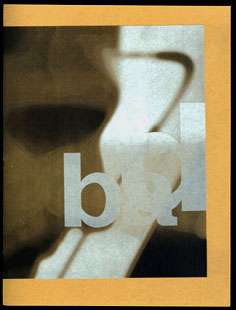 |
Funeral Jar 6 x 13.5"; 32 unnumbered pages. Digitally printed in four colors. Sewn with red paper cover. Title wrapper band in gray which folds as a dust wrapper across the middle of the cover. "Funeral Jar" is a typographic excavation of Thomas Browne's 1858 "Hydrotaphia". Quotations in the original typography are printed in color and interleaved with smaller pages containing the same quotes in modern typography. Wikipedia, 3/24/2023: “Hydriotaphia, Urn Burial, or, a Discourse of the Sepulchral Urns lately found in Norfolk is a work by Sir Thomas Browne, published in 1658 … The title is Greek for "urn burial": A hydria (?δρ?α) is a large Greek pot, and taphos (τ?φος) means "tomb". “Its nominal subject was the discovery of some 40 to 50 Anglo-Saxon pots in Norfolk. The discovery of these remains prompts Browne to deliver, first, a description of the antiquities found, and then a survey of most of the burial and funerary customs, ancient and current, of which his era was aware. “ |
|
| How Books Work By Julie Chen and Clifton Meador Berkeley, California / Chicago: Julie Chen and Clifton Meador, 2011. 4 x 6"; 16 pages. Offset lithography using non-process colors. Interleave structure. Laid in letterfold paper wrapper with slip-in closure. Written, designed, and produced by Chen and Meador at Flying Fish Press in Berkeley, California and the Center for Book and Paper at Columbia College in Chicago. In an age of electronic media and virtual simulacra "What is a book?" is a common question. This is the question that Chen and Meador, two veteran practitioners near the top of any serious list of contemporary book artists, address in "How Books Work." This elegantly simple book marries structure and content in the best tradition of artists' books. It begins: "What is a book? A book is an experience." And ends: "A book starts with an idea. And ends with a reader." (SOLD) |
|
Kora 22.8 x 5.9"; 34 loose pages, stacked as in a traditional Tibetan book structure. Cloth covered boards with screen print in silver of the font Meador developed from his photographs of pilgrims. Title-cloth inset printed in Meador's font. Colophon: "There pictures were taken at the Dege Parkhang, a printing temple located in Ganze Autonomous Prefecture in western China, in August of 2006, with support from a Faculty Development Grant from Columbia College Chicago. This book is part of a larger project about the Parkhang developed by Patrick Dowdey....The figures are line drawings from the photographs, now converted into a font, so the pilgrims have literally turned into language, at least in this book." The Dege Parkhang printing temple. survivor of weather and wars, has become the largest concentration of Tibetan literature in the world — thousands of books preserved as wooden printing blocks Printing is still carried out with these blocks every day weather permits. Pilgrims, circumambulating the exterior of the temple, some carrying prayer wheels their mantras spinning into the ether, are performing kora — an act of devotion and honor to the books housed therein. Meador’s book posits the possibility that the pilgrims through this act of worship become the literature, or at least the language that gives the books life. Wrapped in a Tibetan cloth. |
|
Legal Cuban Cigar 8" x 10"; 56 pages plus a 16-page section bound into paper cover flaps. Printed on a Kodak Nexpress at Appalachian State University. Letterpress cover printed from letters cut on a CNC mill. Numbered. Signed by the artist. Clifton Meador: "The American government has had a fraught relationship with Cuba since the Cuban revolution of 1959. Received imagination portrays Havana as a mobster's playground before the revolution — a glittering city of nightclubs and casinos — but after the revolution? We mostly imagine a country of impoverished farmers, a nation with an excellent national health care system, a place of high literacy, a former client state of the Soviet Union, and home to the finest cigars in the entire world. "The American relationship with Cuba turned sour when Castro finally revealed that Cuba was, in fact, a Marxist, socialist country aligned with the Soviet Union. The failure of the Bay of Pigs invasion attempt, President Kennedy's embargo, and the subsequent Cuban missile crisis were media events played out on television and in newspapers, perhaps the first media-driven international crisis. This mediated spectacle created a 50-year estrangement between Cuba and America that only began to thaw with President Obama's efforts. "I traveled in Cuba in the fall of 2015, right after the renewal of diplomatic relations between the US and Cuba. One of the places I visited was the tobacco-growing region around Viñales. I thought about the irony in the stereotypical fetishization of Cuban cigars by businessmen, a fascination with cigars grown and produced in an impoverished communist country. "The media circus surrounding the Cuban Missile Crisis; a horseback ride to a tobacco barn; my first Cuban Cigar." |
|
| Memory Lapse By Clifton Meador Atlanta, Georgia: Nexus Press, 1999. Edition of 1000. 5.25 x 8", 192 pages. Duotone, tritone and four-color offset printing. Case bound with cloth over boards and offset printed dust jacket. Nexus Press: "Shows Meador's mastery of the form of the visual book in the pacing and interlacing of photos and text. The text uses the layered history of a significant site (a remote Russian monastery that served as the first prison camp in the Gulag) to interrogate the nature of memory and memorials, humanity and inhumanity." Clifton Meador, JAB14: "History itself is a consuming narrative, continually rewritten from the viewpoint of the reader. "Memory Lapse is a question about the nature of monuments and attempts to build a monument that exists in the mind of the reader. One of the functions of a monument is the effort to insert a particular understanding of an event or a person into the narrative of history, to create a permanent reading through the text of the monument. Glorious victories become glorious through the heroism of the monument. Brave warriors are proven brave by a status. Our understanding of the past is written, to some extent, by monuments. But how do we remember the horrors of the past? What kind of monument can we build to our errors? "Russia is full of examples of dreadful terror, governmental actions that killed millions and millions of people. The GULAG, or prison camp system, absorbed people, exploited them in forced labor, and then killed them through neglect and mistreatment. The very first camp was situated in an old monastery on an island in the White Sea, very near the Arctic Circle. The transition of this monastery from one of the holiest monasteries in Russia to one of the most dreadful camps (the arctic Auschwitz according to Solzhenitsyn) is a fascinating shift in reading/meaning, a narrative of uses and signification. Memory Lapse is an inquiry into reading architecture as a shifting narrative, from the beautiful to the horrific, using the Solovetski monastery as its text." (SOLD) |
|
Monet, Mississippi, & Realism 12 x 5.5"; 10 pages. Accordion structure. Inkjet on Somerset Vellum. Letterpress endsheets. Bound in green bookcloth. Printed and produced at the Columbia College Center for Book and Paper Art. Clifton Meador: "We [the artist and his wife, Mary Neal Meador] went hiking a few years ago in the Mississippi Palisade Park in Illinois and I took pictures of the river and railroad. I kept thinking about the difference between Monet (and his insistently aesthetic approach to life) and Samuel Clemen's earthy humanism, hence this book." |
|
Outport Night 6 x 9"; 40 pages. Printed in two-color offset on black paper by Brad Freeman and Clifton Meador at the Center for Book, Paper, and Print at Columbia College Chicago. Hard bound with cloth spine. Clifton Meador: "Long before it became part of Canada, Newfoundland was a European fishing colony. Basque fishermen spent summers in Labrador and Newfoundland fishing and drying cod during the fifteenth century. They might even have been there during the fourteenth century and simply kept quiet about it. "At some point, the incredible richness of the cod fishery in the Grand Banks convinced people to build permanent settlements on shore and to overwinter in Newfoundland. These remote fishing settlements became known as outports and were the source of much of the distinctive character of Newfoundland culture. Glenn Gould created a series of experimental radio pieces for the Canadian Broadcasting Corporation in the late 1960s; one piece, called 'The Latecomers,' deals with the nature of life in an isolated outport in Newfoundland. "Since the 1950s the provincial government in Newfoundland has pursued a policy of resettlement for these remote villages. Nearly all of these villages are hours by boat from any road, and yet they have schools, medical care, power, and sewage infrastructure supplied by the provincial government. Given that most of these places have had declining populations for decades, and given the total collapse of the cod fishery in the 1990s, it is no longer possible to support these remote villages. "Francois (spelled without a cedilla, and pronounced France-way) is a beautiful village on the south coast of Newfoundland, located in a spectacular fjord a six-hour ferry ride from the closest road. A reflection on the end of this way of life, Outport Nights is a book of photographs of Francois, taken at night. This book comes in two versions: the first will be a self-covered wire-stitched version for insertion in JAB45, Spring of 2019, and the second is a hand-sewn case- bound version in a small edition of 40 copies." |
|
| Sporting a Giant Fly Head By Clifton Meador Rochester, New York: Clifton Meador, 2012. Edition of 100. 6 x 9"; 68 pages. Print-on-demand interior casebound book. In a four-color "psychedelic" letterpress printed dust jacket. Black and white photographs taken at Visual Studies Workshop. This is an intriguing and thoughtful discourse on the past, aging, progress, photography, and much more. Don't neglect the footnotes. Clifton Meador: "In December of 2011, I spent a week at the Visual Studies Workshop in Rochester, New York, doing research into the history of photobooks. The archive and library there have wonderful resources, among them an extensive collection of photobooks, with important holdings of some of the great documentary books of the 1930s: American Exodus, Have Your Seen Their Faces, and Paris de Nuit are just a few of the remarkable books there. "The importance of Visual Studies Workshop in the history of artist-produced books (which is just a tricky way of saying artist’s books while trying to avoid the baggage of that term) is moderately well-known in the discourse of book art, but it is still underappreciated. Personally, it was the single greatest source of inspiration for my work, particularly as a young artist. The work of Keith Smith, Joan Lyons, Syl Labrot, Kevin Osborn, Phil Zimmermann, and many others connected to VSW forms some kind of lineage in my practice: I still think about their work often. "So to be there for a week, looking at old books, living in the apartment there was a strange experience of overlaying the past with the present: two of the books I did in the 1990s, Memory Lapse and Whisky Defense, were largely produced there (both were actually printed at Nexus Press). The two projects were the result of intense work in the print studio at VSW (prepress and making film). I spent weeks in those studios – happy, productive weeks of creative ferment. "In the 1958 film The Fly, the protagonist, a visionary young scientist, is the victim of an accident when his invention, a disintegrator-integrator, recombines his body with that of a fly. The resultant chimera, a fly-headed man (along with a human-headed fly) is a nightmarish monster, repugnant but still essentially human, with human desires. The narrative tension between this monster and the slowly developing horror in his human relationship as he becomes less and less human seems like a perfect allegory of aging: the decay of the body is not exactly mirrored by a decay of the mind, and looking into a mirror is more often a shock of horror than a moment of recognition. "Books are clearly objects of memory and that they function as repositories of the past is an obvious idea. Spending time with old books from my personal past was doubly resonant, and to do so in a place that is filled my own memories was very dislocating. "I printed a four-color letterpress dust jacket for this work as a way of trying to make the material object of this book less indistinct: one problem with print-on-demand books is that the one-size-fits-all nature of the process produces a homogenized work (to use Buzz Spector’s clever observation) a work that lacks presence through individuality. "And there is one advantage to having a fly head: a fly’s compound eyes see things that we cannot imagine." (SOLD/Out of Print) |
|
Three Tibetan Bookstores 6.125 x 8.125"; 12 pages. One fold-out page extends image 2 to 22". Letterpress, offset, and laser printing. "Partially Enumerating Tibetan Buddhism" pamphlet (3 x 5.25"; 32 pages) housed in library card envelope on inner back flap. Printed at the Center for Editions, Purchase College and at the Center for Book & Paper, Columbia College Chicago. Meador combines five components: photographs of thee bookstores in China, a photograph of a monk purchasing a book, and a pamphlet "Enumerating Tibetan Buddhism.” Clifton Meador: "’Enumerating Tibetan Buddhism' is a compilation of topic entries from three English-Tibetan dictionaries I bought in China. One was actually printed in India and has some very funny English. I went through these books, and extracted entries that used numbers as a mnemonic device to teach various aspects of Tibetan metaphysics. I was struck by the way numbers are so important in their Buddhism. In the Christian tradition I was raised in, three was about as large a number as we talked about frequently. They have thousands of Buddhas.… “The font in this book is the same font in Kora. This time it encodes a story about how frustrating it was to try to buy books when I couldn't read the language at all. (If a reader were patient and willing to take the trouble, it would be possible to decode the cipher using an English frequency of occurrence table to figure out which drawings stand for which letters.) I thought there was some abstract conceptual connection in this idea (an unreadable story about not being able to read books) that might be interesting/funny. I think that at least people will get the idea that there is some kind of text on those pages that is unreadable. “The little book in the back is supposed to give some idea about what might be in those unreadable books. The form, that of a library card, suggests that the ownership of the books (part of the function of a library card is to assert control and ownership of a book) would be full of frustration: the little book is full of mnemonic codes for abstract spiritual ideas, and offers no access to those ideas and practices. The reader is faced with knowing something that isn't particularly informative or helpful. It is part of my daily experience, being overwhelmed with tons of useless information, but information that gives me the illusion of knowledge. “The entire piece reflects on book ownership, at least my own relationship with books. I have a degree of book lust for books that is sometimes out of control: many times I would rather have a book than an actual experience. I see some problems with that, but I still really love books. “Even books I can't read!” |
|
Page last update: 11.08.2024
Home | About Us | Contact Us | New Arrivals | Fine Press & Artists' Books | Broadsides |Resource Books | Order/Inquiry
Copyright © 2021 Vamp & Tramp, Booksellers, LLC. All rights reserved.
